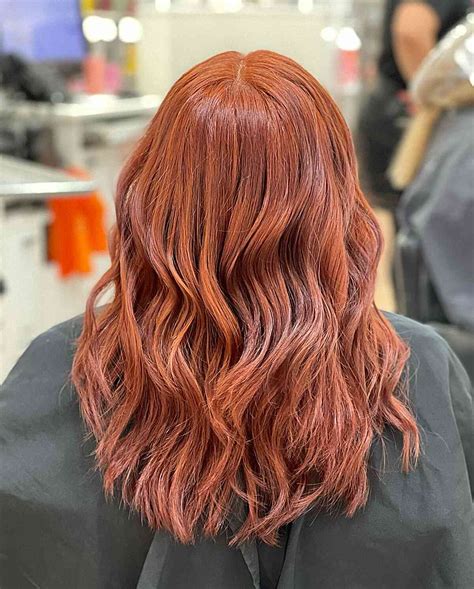What is Auburn Red Hair?
Auburn red hair is a natural hair color characterized by a reddish-brown hue. It falls within the ginger hair family, which ranges from strawberry blonde to deep copper. Auburn hair is often associated with Celtic heritage, particularly in Ireland and Scotland.

Prevalence and Genetics
- According to the University of Edinburgh, auburn hair is found in approximately 1-2% of the global population.
- It is more common in Northern and Western Europe, with the highest prevalence in Ireland (10%).
- The gene responsible for auburn hair, known as MC1R, codes for a protein involved in melanin production.
Characteristics and Subtypes
Auburn hair typically exhibits the following characteristics:
- Reddish-brown hue
- Medium to dark blonde base
- Warm, golden undertones
- Can range from light strawberry blonde to dark copper
Subtypes of auburn hair include:
- Light auburn: A blend of strawberry blonde and light copper with a more blonde base.
- Medium auburn: A warm, medium-toned shade with a balance of blonde and copper.
- Dark auburn: A deep, reddish-brown shade with prominent copper tones.
Auburn Red Hair in Society
Historical Significance:
- Auburn hair has been a symbol of Celtic culture for centuries.
- In Ancient Greece, red-haired women were often associated with Aphrodite, the goddess of beauty.
- During the Middle Ages, auburn hair was sometimes considered a sign of witchcraft or heresy.
Cultural Implications:
- In modern times, auburn hair is generally perceived as attractive and alluring.
- It has been featured in numerous works of art, literature, and music.
- Famous auburn-haired people include Jessica Chastain, Emma Stone, and Ed Sheeran.
Benefits and drawbacks of Auburn Red Hair
Benefits:
- Natural and unique: Auburn hair stands out as a distinctive and memorable hair color.
- Complements various skin tones: It can flatter a wide range of skin tones, from fair to dark.
- Enhances natural blush: The warm tones of auburn hair can accentuate natural blush, giving a healthy, radiant appearance.
Drawbacks:
- Fades easily: Auburn hair tends to fade more quickly than other hair colors due to its warm pigments.
- Requires regular touch-ups: To maintain the desired shade, frequent touch-ups are necessary.
- Can be difficult to achieve: Naturally achieving or maintaining auburn hair requires specific hair coloring techniques.
How to Achieve Auburn Red Hair
Natural Ways:
- Henna: A natural dye derived from the henna plant can add auburn tones to hair.
- Pomegranate juice: Applying pomegranate juice to hair can help enhance red tones.
- Hibiscus: Steeping hibiscus flowers in water and applying the liquid to hair can impart auburn hues.
Chemical Ways:
- Hair dye: Commercial hair dyes are available in a range of auburn shades.
- Toning: Using a toner specifically designed for auburn hair can add or enhance the desired shade.
- Balayage: A highlighting technique that can create natural-looking auburn highlights.
Caring for Auburn Red Hair
- Use color-safe shampoos and conditioners: These products are designed to preserve hair color and prevent fading.
- Limit heat styling: Heat can damage hair and cause fading.
- Use UV protection: Sun exposure can also lead to fading. Use a leave-in conditioner or spray with UV protection.
- Moisturize regularly: Auburn hair tends to be drier, so regular moisturizing is essential.
Common Questions about Auburn Red Hair
Can you dye dark hair auburn red?
Yes, it is possible to dye dark hair auburn red, but it may require bleaching to achieve the desired shade.
How long does auburn red hair dye last?
The longevity of auburn red hair dye depends on the type of dye used, the hair’s condition, and the frequency of washing. Semi-permanent dyes typically last 4-6 weeks, while permanent dyes can last several months.
What is the best way to maintain auburn red hair?
To maintain the color and health of auburn red hair, use color-safe products, limit heat styling, use UV protection, and moisturize regularly.
Tips and Tricks for Auburn Red Hair
- Experiment with different shades of auburn to find the perfect match for your skin tone.
- Add highlights or lowlights to create depth and dimension in your hair.
- Use temporary hair color products to try out auburn without committing to a permanent change.
- Accentuate your auburn hair with makeup that complements warm tones.
- Embrace the unique beauty of your auburn red hair and wear it with confidence.
Conclusion
Auburn red hair is a stunning and versatile hair color with a rich history and cultural significance. Whether you achieve it naturally or through chemical means, caring for and maintaining auburn red hair requires proper products and techniques. By following these tips and tricks, you can keep your auburn hair looking vibrant and healthy for years to come.
Tables
Table 1: Prevalence of Auburn Red Hair
| Region | Percentage of Population with Auburn Red Hair |
|---|---|
| Ireland | 10% |
| Scotland | 6% |
| Wales | 4% |
| England | 2% |
| United States | 1-2% |
| Global | 1-2% |
Table 2: Subtypes of Auburn Red Hair
| Subtype | Characteristics |
|---|---|
| Light Auburn | Strawberry blonde base, warm copper undertones |
| Medium Auburn | Balanced blend of blonde and copper, warm golden tones |
| Dark Auburn | Deep reddish-brown base, prominent copper tones |
Table 3: Benefits of Auburn Red Hair
| Benefit | Explanation |
|---|---|
| Natural and unique | Stands out as a distinctive hair color |
| Complements various skin tones | Flatters a wide range of skin tones, from fair to dark |
| Enhances natural blush | Accentuates natural blush, giving a healthy appearance |
Table 4: Drawbacks of Auburn Red Hair
| Drawback | Explanation |
